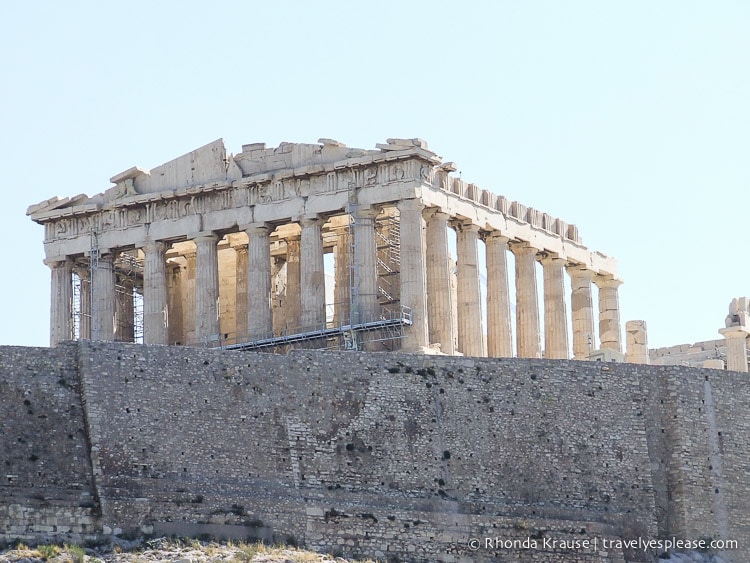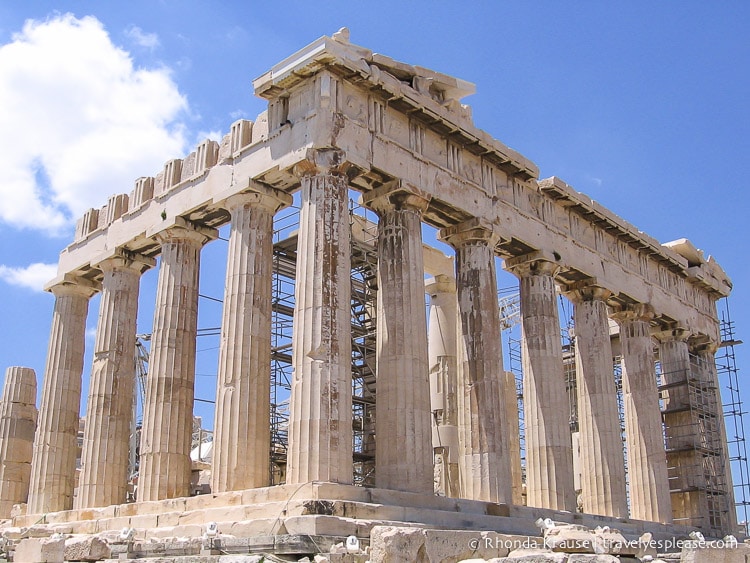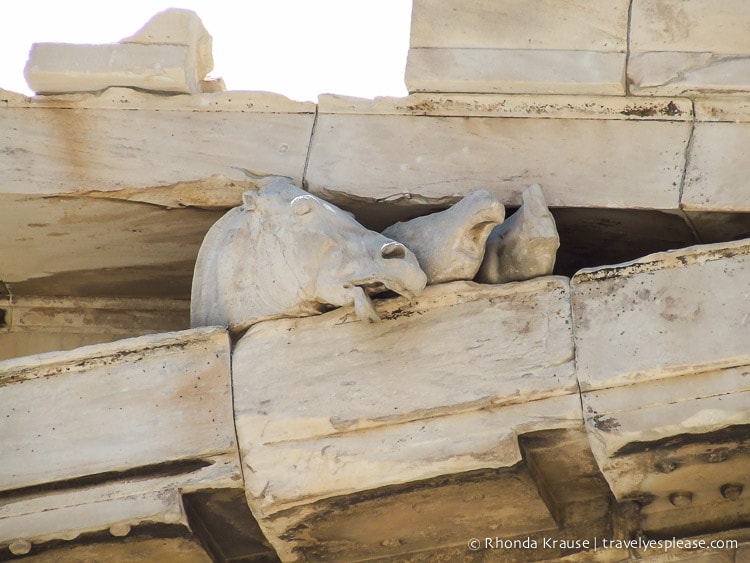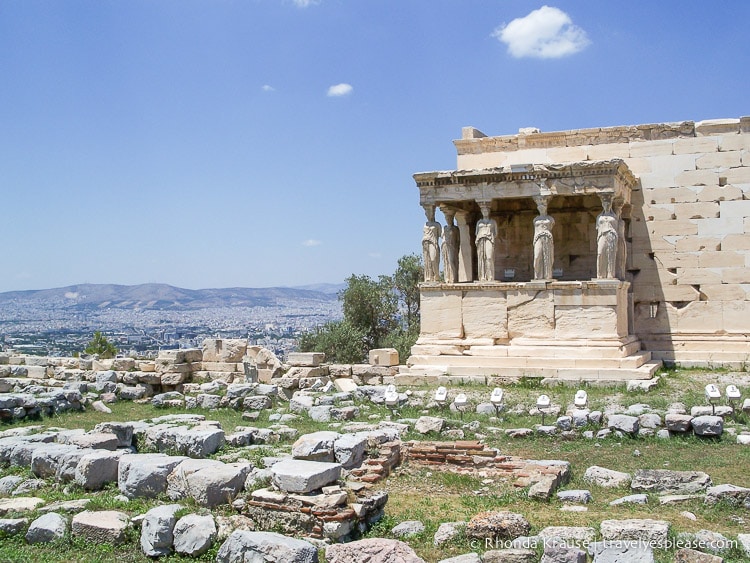Tour of the Acropolis- Athens’ High City
Purchases made through links earn us a small commission, at no extra cost to you.
From almost any point within Athens you can see the Acropolis standing high above the city, a monumental beauty built in homage to Athena, the goddess of wisdom.

When I arrived in Athens, I could not wait to visit the Acropolis, one of the most famous ancient Greek sites. Walking towards it and getting my first glimpse was exhilarating. I knew the Acropolis was the “High City”, but it was much higher than I was expecting, built on an almost completely vertical, flat-topped pedestal of rock. As grand as the Acropolis is, it manages to stand in harmony with its natural setting.
As with all archaeological sites, I found the history surrounding the Acropolis to be intriguing. It’s easy to see why it’s listed as a UNESCO World Heritage Site and regarded as the most important ancient monument in the Western World. So before I share my self-guided tour of the Acropolis, here’s a brief history of the ancient Acropolis of Athens.
History of the Acropolis
The first temples of the Acropolis were built in Mycenaean times but the city itself was first inhabited during the Neolithic era. Reduced to ashes after a battle with the Persians in 480 BC, the Acropolis was rebuilt by Pericles, an Athenian statesman, to what we are familiar with today.

Pericles’ ambitious rebuilding program was brought to fruition by Pheidias, a great Athenian sculptor, and Ictinus and Callicrates, two famous architects. Together, they transformed the Acropolis into a city of temples and centre for thought and the arts. No expense was spared and soon the Acropolis became a showcase of grandiose statues and colossal buildings.
The monuments that remain today have survived earthquakes and years of foreign occupation by the Byzantines, Frankish lords and the Turks. The most significant damage to the Acropolis occurred in 1687 when the Venetian army attacked, causing the Parthenon to explode from the gunpowder that the Turks were storing inside.
Tour of the Acropolis- Archaeological Remains
Here’s a look at the archaeological remains I saw during my self-guided tour of the Acropolis.
The Propylaea
The Propylaea serves as the monumental entrance to the Acropolis. Built between 437 and 432 BC of white Pentelic marble, it consisted of a central hall with two adjoining wings on each side. The central hall was built with five gates through which people had to pass to visit parts of the Acropolis. The six-columned Doric façade on the East and West of the Propylaea echo the proportions of the columns of the Parthenon.

The ceiling of the Propylaea was famous in antiquity for it’s beauty. It was painted dark blue with gold stars and had marble blocks carved in the shape of ceiling coffers. Sounds gorgeous!
The building was badly damaged in 1656 when lightning struck a Turkish gunpowder store, setting off an explosion. Could this have been foreshadowing for what was to happen to the Parthenon 31 years later?

Temple of Athena Nike
The first building to greet visitors entering at the Propylaea, is the Classical temple of Athena Nike. The temple once housed a statue of the goddess Athena and the frieze illustrated scenes from mythology and Athenian battles. The temple is usually perched on a platform to the right of the Propylaea, but was partially removed for repairs when I visited in 2007.
Instead of focusing on the unsightly scaffolding you see in the pictures above, I had to use my imagination to picture the square, Pentelic marble temple with four Ionic columns gracing each end. I’m sure it’s as stunning as I imagined.
Parthenon
When most people think of the Acropolis, the first monument to come to mind is the Parthenon. The largest Doric temple to be completed in Greece, the Parthenon encapsulates ancient Greece’s glory.

The Parthenon was built completely of Pentelic marble except for its wooden roof. The ceiling was painted blue with gold stars, similar to that of the Propylaea. Eight doric columns made up the facade and 17 columns lined each side of the temple.

I found the way in which the Parthenon was constructed to be quite interesting. The Greeks may have been aware that two parallel lines appear to curve outward when intersected by converging lines. To compensate for this illusion, the Greeks added their own curves. The platforms on which the columns stand are slightly concave and the columns themselves are slightly convex so that both appear straight.



Built in 15 years, the Parthenon was to serve two purposes- to act as the new treasury and to house a great statue of Athena, the Athena Polias (Athena of the City).
The gold and ivory statue of Athena was created by Pheidias and stood almost 12 metres high. Athena’s eyes were made out of jewels and she was clad in a long dress of gold. She held a spear in her left hand and a statuette of Nike, goddess of victory, in her right. A helmet decorated with a sphinx and griffins sat on top of her head. This magnificent statue of the armed Goddess was taken to Constantinople in AD 426, where it disappeared. Oddly, there is a modern reproduction of the statue in Nashville, Tennessee of all places!
Erechtheion
The Erechtheion is an intricate and elegant temple built to accommodate religious rituals. It is built on the most sacred part of the Acropolis, where Poseidon is said to have struck the ground with his trident and where Athena produced the olive tree, a gift to the city of Athens.

The temple is of the Ionic order and was built on several different levels to counteract the ground’s unevenness. The building consisted of the main temple and two porches. The north porch’s roof was supported by six Ionic columns and below it’s floor is the mark of Zeus’ thunderbolt, sent to kill King Erechtheus.

The Erechtheion’s signature feature are the Caryatids- six maiden columns that support the weight of the south porch’s roof on their heads (and they make it look so easy!) Below the porch is said to be the grave of Kekrops, another King of Athens. The Caryatids you see on site today are actually plaster casts. Five of the originals are in the Acropolis museum and the sixth maiden, the one removed by Lord Elgin, is in the British Museum.

The Southern Slope of the Acropolis
Below the High City are some more archaeological remains that are included in the site fee.
Theatre of Dionysos
This enormous stone and marble theatre was constructed between 342-326 BC. Only 20 of the 64 original tiers built to accommodate 17,000 spectators remain.

The front row was reserved for important priests and officials who enjoyed the show while sitting in thrones built of Pentelic marble. All other seats were made from Piraeus limestone and were occupied by ordinary citizens, with women being relegated to the back rows.

The grandest seat in the theatre was in the very centre. It was specially marked with lion-claw feet on each side and was shaded by a canopy. This seat was reserved for the Priest of Dionysos.
Odeon of Herodes Atticus
This theatre was built in AD 161 by Herodes Atticus who constructed it in memory of his wife, Regilla. The theatre is only open to the public during performances. During the Athens Festival, you can see performances of music, dance and drama in the Odeon of Herodes Atticus.

Tips for Visiting the Acropolis
Admission Fees: Admission to the Acropolis archaeological site, including the north and south slopes, is €20. For €30 you can get a combination ticket that includes entrance to the Ancient Agora, Roman Agora, Hadrian’s Library, Keramikos, Temple of Olympian Zeus, and the Archaeological Site of Lykeion. The special ticket package is valid for five days. Confirm current ticket prices here.
- A separate ticket is needed for visiting the Acropolis Museum nearby the archaeological site.
Opening Hours: Acropolis visiting hours are from 8:00 am- 5:00 pm (last admission at 4:30 pm) in the winter and 8:00 am- 8:00 pm (last admission at 7:30 pm) in the summer. Confirm current hours here.
Entrance: The main entrance to the Acropolis is from Dionysiou Areopagitou, near Odeon of Herodes Atticus. You can also enter at the Theatre of Dionysos, near the Akropoli metro station.
Security: If you are carrying a large bag or backpack, you will be required to leave it at the main entrance cloakroom. Small backpacks and handbags are allowed in the Acropolis archaeological site.
- At the time of my visit, security would yell and get very irate with people who would attempt to take pictures holding their country’s flag. I even saw them take a camera from one group and demand the photo to be erased. Apparently, flags are not allowed for some silly reason.
Accessibility: The Acropolis is wheelchair accessible via an elevator on the northern side. Ask for assistance at the main entrance.
More Tips: Wear sturdy shoes because the paths are slippery and uneven.
- It gets incredibly hot and crowded here, so try to arrive first thing in the morning, late afternoon, or early evening.
Information was updated January 2025, but can change without notice. Please confirm directly with service providers.

Tours of the Acropolis
Here is a trusted site where you can book tours and activities in Athens. These are a few highly rated tours of the Acropolis and museum I picked out.
Accommodations in Athens
For your convenience, here is a list of hotels in Athens. Please consider booking your Athens accommodations through the included link. It costs nothing extra and helps support this website. Thank you!
More Greece Destinations and Travel Guides
- Ancient Delphi- The Navel of the World
- Ancient Olympia- Birthplace of the Olympic Games
- Knossos Palace- Discovering Minoan Culture and Mythology
- How Athens Taught Me to Travel Differently
